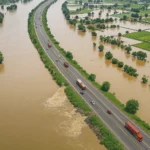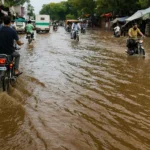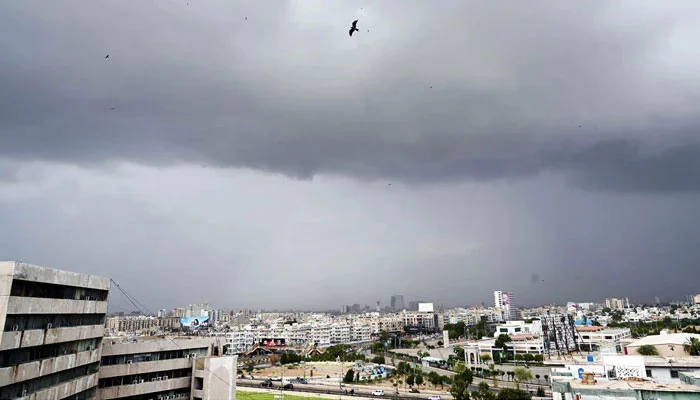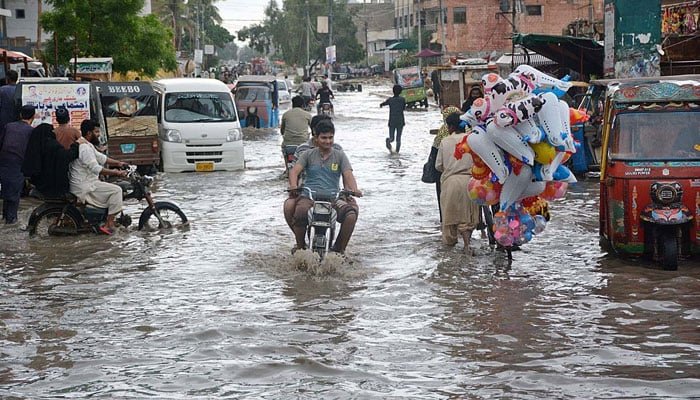☁️ Overcast Skies, Light Rain Expected in Karachi
Karachi, Pakistan’s commercial hub on the Arabian Sea, is predicted to remain under extensive cloud cover over the next 24 hours, with intermittent light rain or drizzle possible. According to the Pakistan Meteorological Department (PMD), a humid, overcast atmosphere will persist, accompanied by a gentle sea breeze offering mild relief from the stifling heat.
Key Forecast Details:
-
Maximum temperature: Between 33°C and 35°C.
-
Minimum recorded temperature (past 24 hrs): 29°C.
-
Humidity level: Around 78%.
-
Wind speed: Light sea breeze at ~11 km/h.
The current cloud cover and occasional drizzle are expected to provide momentary relief to Karachiites enduring the city’s ongoing muggy conditions. Importantly, the PMD has stated that heavy rainfall is not anticipated in Karachi, unlike parts of the country currently experiencing monsoon deluges.
🌧️ Monsoon Weather Alert Across Pakistan (July 13–17)
Widespread Rainfall and Storm Activity
Meteorologists have noted that moist air currents, pulling significant humidity from the Bay of Bengal and Arabian Sea, are intensifying a monsoon wave sweeping across the region. A fresh westerly disturbance is expected to arrive on the evening of Sunday, July 13, amplifying instability in the atmosphere. This synoptic combination is already producing widespread rainfall, thunder, and gusty winds in northern and central Pakistan.
Areas affected since July 13 include:
-
Okara and Arifwala (Punjab)
-
Kohlu and Rajanpur (Balochistan/Punjab border)
-
South Waziristan (Khyber Pakhtunkhwa)
Although rains have been intermittent, some regions are witnessing heavier downpours. Forecasts suggest that this pattern will persist through Thursday, July 17.
Rainfall Outlook by Region
| Region | Forecasted Rainfall | Timing (July 13–17) |
|---|---|---|
| Northeast & North Punjab | Heavy to very heavy | High risk of flash floods in streams, nullahs |
| Hilly Areas (KP, Kashmir, Gilgit-Baltistan) | Intense rain, landslides | Road closures expected |
| Earthen Rivers / Torrent Streams | Swelling of water flows | Medium flood levels at barrage sites (Indus, Kabul, etc.) |
| Southern Punjab & NE Balochistan | Moderate to heavy | Tributaries may flood rural and urban zones |
| Urban Centers (Islamabad, Lahore, Peshawar, etc.) | Urban flooding risk | Local drainage overload likely between July 13–17 |
🚨 National Disaster Management Authority (NDMA) Red Alert
With the monsoon system peaking between July 13 and 17, the NDMA has issued a nationwide alert. The forecast indicates:
-
A sustained moisture flow from both seas.
-
Enhancement by a new westerly wave since the evening of July 13.
-
Elevation of flows in major river systems—Indus, Kabul, Jhelum, Chenab.
River Flood Scenarios
-
Kalabagh, Chashma, Taunsa Barrages: Medium flood stage expected.
-
Tributaries & hill torrents: Possibility of localized flooding, especially in southern Punjab and northeastern Balochistan.
NDMA has urged residents near water bodies to:
-
Remain vigilant and monitor flash-flood and urban flooding advisories.
-
Prepare an emergency kit including first-aid supplies, drinking water, flashlights, and sturdy shoes.
-
Avoid crossing swollen streams, nullahs, and small bridges during rainfall.
District disaster response units have been advised to:
-
Pre-position sandbags and portable pumps.
-
Allocate resources in low-lying and vulnerable communities.
-
Disseminate public warnings through sirens, mosque announcements, social media, and SMS channels.
🔍 Region-by-Region Impact Analysis & Guidance
1. Murree, Galliyat, Swat, Dir, Kohistan, Abbottabad, Islamabad, Rawalpindi (FATA/KP Punjab border)
-
Risks: Heavy to very heavy rain; flash floods, landslides; electric pole damage.
-
Advice:
-
Avoid forested gullies, mountain streams, and landslide-prone routes.
-
Travelers and tourists should reconsider high-altitude trips.
-
Maintenance crews to secure billboards, tents, and temporary structures.
-
2. Northeast Punjab & Major Cities (Lahore, Rawalpindi, Gujranwala, etc.)
-
Risks: Heavy showers, urban flooding due to poor drainage.
-
Advice:
-
Residents in low-lying colonies please time outdoor travel accordingly.
-
Municipalities should clear storm sewers, ensure pumps are operational.
-
Use public advisories to deter people from visiting flood-prone districts.
-
3. Khyber Pakhtunkhwa Hill Zones & Kashmir
-
Risks: Mudslides, road blockages, utility damage.
-
Advice:
-
Road transport authorities to place warning signs and mobilize road-clearing teams.
-
Emergency shelters to be available in vulnerable communities.
-
Tourists in northern valleys to monitor PMD and local advisories.
-
4. Southern Punjab and NE Balochistan
-
Risks: Hill torrent flooding of small communities and farmland.
-
Advice:
-
Farmers advised to relocate livestock from streambeds.
-
Ensure crops are secured or sheltered.
-
Local administrative authorities to survey and evacuate at-risk settlements.
-
5. Major River Barrage Locations (Kalabagh, Chashma, Taunsa)
-
Risks: Medium-level floods; backwater affecting adjacent settlements.
-
Advice:
-
District administrations to maintain flood canals and protective embankments.
-
Early warnings to residents downstream from barrage spillovers.
-
🌬️ Weather Dynamics: Technical Insights
1. Monsoon Mechanism in Pakistan
-
Driven by heated landmass pulling in warm, moisture-rich air from the Bay of Bengal & Arabian Sea.
-
This season, intensified by a mid-latitude westerly trough arriving July 13, which:
-
Strengthens convection (thunderstorm activity).
-
Helps form low-pressure systems over northern Pakistan, bringing torrential rain.
-
2. Sea Breeze and Coastal Effects
-
Karachi’s shore breeze (~11 km/h) helps temper peak temperatures but adds humidity.
-
Coastal air doesn’t sink far inland; hence, generated clouds may cause local showers.
3. Hydrological Cascading Effects
-
Heavy upstream rains feed hill torrents → flash floods.
-
These streams discharge into larger rivers → barrage pressure and urban inundation.
-
Urban surfaces exacerbate runoff due to limited drainage capacity.
💧 Preparedness Checklist & Advisory Summary
General Public:
-
Stay informed: Regularly check PMD and NDMA alerts via SMS and news.
-
Avoid risky zones: No crossings of flooded roads, bridges, nullahs.
-
Keep emergency kits ready: Water, non-perishable food, medicines, torch, battery charger.
-
Stay indoors during heavy downpours or thunderstorms.
Tourists & Travelers:
-
Plan routes carefully—avoid hill areas prone to landslides (Murree, Swat, etc.).
-
Seek local guidance and check road status before planning mountain excursions.
-
If disrupted, remain in safe shelters until police or rescue teams permit passage.
Farmers & Livestock Owners:
-
Shift animals from streambeds and uncovered yards to elevated areas.
-
Cover sensitive crops and ensure proper drainage.
-
Postpone planting or harvesting until spells of rain subside.
District & Local Authorities:
-
Pre-stage resources: lifesaving equipment, generators, rescue boats.
-
Clear urban drains, repair damaged sewers ahead of forecast rains.
-
Prepare shelters and transport plans for quick evacuation in flood-risk zones.
-
Communicate proactively: Send updates via loudspeakers, mosques, schools, mobile networks.
Utilities & Infrastructure Agencies:
-
Secure electricity poles, transformers, overhead wires.
-
Inspect drainage and culverts, remove debris.
-
Check structural integrity of bridges and walls in high-risk regions.
📰 On the Ground – Community Experience
People in Islamabad raised concerns as lower neighborhoods reported water logging in residential areas. Qasim, a Karachi office worker, said:
“The drizzle yesterday evening brought some relief, but the humidity is still unbearable,”
—reflecting the frustration alongside brief comfort provided by recent light rain.
Meanwhile, in Murree, locals noted the return of thunder by afternoon of July 13—a sign that the forthcoming 48–72 hours of rainfall could be the most intense of this monsoon cycle.
📆 What to Expect in the Coming Days
-
July 14–15: Peak rainfall expected in northern Pakistan—Murree, Swat, Dir—with strong winds and possible contamination of drinking water sources in downstream areas.
-
July 16–17: Potential flood episodes near barrages and adjoining canal systems in Punjab; urban flooding risk peaks in major cities.
-
Post-July 17: Eastern monsoon activity may wane temporarily due to upper-level dynamics, though localized rainfall could persist.
📢 Final Advisory & Conclusion
Pakistan’s ongoing monsoon phase, heightened by a westerly wave since July 13, is producing widespread rain—from drizzles in Karachi to heavy thunderstorms and flood risk in northern and central regions. With weather activity continuing through July 17:
-
Stay alert: Monitor PMD/NDMA warnings.
-
Take precautions: Avoid travel in high-risk zones, keep homes and communities prepared with drainage and emergency kits.
-
Authorities remain vigilant: District bodies must coordinate quickly—clearing drains, securing infrastructure, and organizing evacuations where needed.
-
Follow official guidance: In case of flash floods or landslides, head to appointed shelters and comply with rescue directives.
This monsoon spell is a reminder of the dual nature of rain—it can be both life-giving and life-threatening. Careful planning and collective response can help mitigate its challenges. By staying informed and prepared, communities across Pakistan can weather this weather wave with resilience and safety.
☁️ Overcast Skies, Light Rain Expected in Karachi
Karachi, Pakistan’s commercial hub on the Arabian Sea, is predicted to remain under extensive cloud cover over the next 24 hours, with intermittent light rain or drizzle possible. According to the Pakistan Meteorological Department (PMD), a humid, overcast atmosphere will persist, accompanied by a gentle sea breeze offering mild relief from the stifling heat.
Key Forecast Details:
-
Maximum temperature: Between 33°C and 35°C.
-
Minimum recorded temperature (past 24 hrs): 29°C.
-
Humidity level: Around 78%.
-
Wind speed: Light sea breeze at ~11 km/h.
The current cloud cover and occasional drizzle are expected to provide momentary relief to Karachiites enduring the city’s ongoing muggy conditions. Importantly, the PMD has stated that heavy rainfall is not anticipated in Karachi, unlike parts of the country currently experiencing monsoon deluges.
______________________________________________________________________
Rifts crop up in PTI over timeline of protest movement
Raed Yjois Article
🌧️ Monsoon Weather Alert Across Pakistan (July 13–17)
Widespread Rainfall and Storm Activity
Meteorologists have noted that moist air currents, pulling significant humidity from the Bay of Bengal and Arabian Sea, are intensifying a monsoon wave sweeping across the region. A fresh westerly disturbance is expected to arrive on the evening of Sunday, July 13, amplifying instability in the atmosphere. This synoptic combination is already producing widespread rainfall, thunder, and gusty winds in northern and central Pakistan.
Areas affected since July 13 include:
-
Okara and Arifwala (Punjab)
-
Kohlu and Rajanpur (Balochistan/Punjab border)
-
South Waziristan (Khyber Pakhtunkhwa)
Although rains have been intermittent, some regions are witnessing heavier downpours. Forecasts suggest that this pattern will persist through Thursday, July 17.
Rainfall Outlook by Region
| Region | Forecasted Rainfall | Timing (July 13–17) |
|---|---|---|
| Northeast & North Punjab | Heavy to very heavy | High risk of flash floods in streams, nullahs |
| Hilly Areas (KP, Kashmir, Gilgit-Baltistan) | Intense rain, landslides | Road closures expected |
| Earthen Rivers / Torrent Streams | Swelling of water flows | Medium flood levels at barrage sites (Indus, Kabul, etc.) |
| Southern Punjab & NE Balochistan | Moderate to heavy | Tributaries may flood rural and urban zones |
| Urban Centers (Islamabad, Lahore, Peshawar, etc.) | Urban flooding risk | Local drainage overload likely between July 13–17 |
🚨 National Disaster Management Authority (NDMA) Red Alert
With the monsoon system peaking between July 13 and 17, the NDMA has issued a nationwide alert. The forecast indicates:
-
A sustained moisture flow from both seas.
-
Enhancement by a new westerly wave since the evening of July 13.
-
Elevation of flows in major river systems—Indus, Kabul, Jhelum, Chenab.
River Flood Scenarios
-
Kalabagh, Chashma, Taunsa Barrages: Medium flood stage expected.
-
Tributaries & hill torrents: Possibility of localized flooding, especially in southern Punjab and northeastern Balochistan.
NDMA has urged residents near water bodies to:
-
Remain vigilant and monitor flash-flood and urban flooding advisories.
-
Prepare an emergency kit including first-aid supplies, drinking water, flashlights, and sturdy shoes.
-
Avoid crossing swollen streams, nullahs, and small bridges during rainfall.
District disaster response units have been advised to:
-
Pre-position sandbags and portable pumps.
-
Allocate resources in low-lying and vulnerable communities.
-
Disseminate public warnings through sirens, mosque announcements, social media, and SMS channels.
🔍 Region-by-Region Impact Analysis & Guidance
1. Murree, Galliyat, Swat, Dir, Kohistan, Abbottabad, Islamabad, Rawalpindi (FATA/KP Punjab border)
-
Risks: Heavy to very heavy rain; flash floods, landslides; electric pole damage.
-
Advice:
-
Avoid forested gullies, mountain streams, and landslide-prone routes.
-
Travelers and tourists should reconsider high-altitude trips.
-
Maintenance crews to secure billboards, tents, and temporary structures.
-
2. Northeast Punjab & Major Cities (Lahore, Rawalpindi, Gujranwala, etc.)
-
Risks: Heavy showers, urban flooding due to poor drainage.
-
Advice:
-
Residents in low-lying colonies please time outdoor travel accordingly.
-
Municipalities should clear storm sewers, ensure pumps are operational.
-
Use public advisories to deter people from visiting flood-prone districts.
-
3. Khyber Pakhtunkhwa Hill Zones & Kashmir
-
Risks: Mudslides, road blockages, utility damage.
-
Advice:
-
Road transport authorities to place warning signs and mobilize road-clearing teams.
-
Emergency shelters to be available in vulnerable communities.
-
Tourists in northern valleys to monitor PMD and local advisories.
-
4. Southern Punjab and NE Balochistan
-
Risks: Hill torrent flooding of small communities and farmland.
-
Advice:
-
Farmers advised to relocate livestock from streambeds.
-
Ensure crops are secured or sheltered.
-
Local administrative authorities to survey and evacuate at-risk settlements.
-
5. Major River Barrage Locations (Kalabagh, Chashma, Taunsa)
-
Risks: Medium-level floods; backwater affecting adjacent settlements.
-
Advice:
-
District administrations to maintain flood canals and protective embankments.
-
Early warnings to residents downstream from barrage spillovers.
-
🌬️ Weather Dynamics: Technical Insights
1. Monsoon Mechanism in Pakistan
-
Driven by heated landmass pulling in warm, moisture-rich air from the Bay of Bengal & Arabian Sea.
-
This season, intensified by a mid-latitude westerly trough arriving July 13, which:
-
Strengthens convection (thunderstorm activity).
-
Helps form low-pressure systems over northern Pakistan, bringing torrential rain.
-
2. Sea Breeze and Coastal Effects
-
Karachi’s shore breeze (~11 km/h) helps temper peak temperatures but adds humidity.
-
Coastal air doesn’t sink far inland; hence, generated clouds may cause local showers.
3. Hydrological Cascading Effects
-
Heavy upstream rains feed hill torrents → flash floods.
-
These streams discharge into larger rivers → barrage pressure and urban inundation.
-
Urban surfaces exacerbate runoff due to limited drainage capacity.
💧 Preparedness Checklist & Advisory Summary
General Public:
-
Stay informed: Regularly check PMD and NDMA alerts via SMS and news.
-
Avoid risky zones: No crossings of flooded roads, bridges, nullahs.
-
Keep emergency kits ready: Water, non-perishable food, medicines, torch, battery charger.
-
Stay indoors during heavy downpours or thunderstorms.
Tourists & Travelers:
-
Plan routes carefully—avoid hill areas prone to landslides (Murree, Swat, etc.).
-
Seek local guidance and check road status before planning mountain excursions.
-
If disrupted, remain in safe shelters until police or rescue teams permit passage.
Farmers & Livestock Owners:
-
Shift animals from streambeds and uncovered yards to elevated areas.
-
Cover sensitive crops and ensure proper drainage.
-
Postpone planting or harvesting until spells of rain subside.
District & Local Authorities:
-
Pre-stage resources: lifesaving equipment, generators, rescue boats.
-
Clear urban drains, repair damaged sewers ahead of forecast rains.
-
Prepare shelters and transport plans for quick evacuation in flood-risk zones.
-
Communicate proactively: Send updates via loudspeakers, mosques, schools, mobile networks.
Utilities & Infrastructure Agencies:
-
Secure electricity poles, transformers, overhead wires.
-
Inspect drainage and culverts, remove debris.
-
Check structural integrity of bridges and walls in high-risk regions.
📰 On the Ground – Community Experience
People in Islamabad raised concerns as lower neighborhoods reported water logging in residential areas. Qasim, a Karachi office worker, said:
“The drizzle yesterday evening brought some relief, but the humidity is still unbearable,”
—reflecting the frustration alongside brief comfort provided by recent light rain.
Meanwhile, in Murree, locals noted the return of thunder by afternoon of July 13—a sign that the forthcoming 48–72 hours of rainfall could be the most intense of this monsoon cycle.
📆 What to Expect in the Coming Days
-
July 14–15: Peak rainfall expected in northern Pakistan—Murree, Swat, Dir—with strong winds and possible contamination of drinking water sources in downstream areas.
-
July 16–17: Potential flood episodes near barrages and adjoining canal systems in Punjab; urban flooding risk peaks in major cities.
-
Post-July 17: Eastern monsoon activity may wane temporarily due to upper-level dynamics, though localized rainfall could persist.
📢 Final Advisory & Conclusion
Pakistan’s ongoing monsoon phase, heightened by a westerly wave since July 13, is producing widespread rain—from drizzles in Karachi to heavy thunderstorms and flood risk in northern and central regions. With weather activity continuing through July 17:
-
Stay alert: Monitor PMD/NDMA warnings.
-
Take precautions: Avoid travel in high-risk zones, keep homes and communities prepared with drainage and emergency kits.
-
Authorities remain vigilant: District bodies must coordinate quickly—clearing drains, securing infrastructure, and organizing evacuations where needed.
-
Follow official guidance: In case of flash floods or landslides, head to appointed shelters and comply with rescue directives.
This monsoon spell is a reminder of the dual nature of rain—it can be both life-giving and life-threatening. Careful planning and collective response can help mitigate its challenges. By staying informed and prepared, communities across Pakistan can weather this weather wave with resilience and safety.












